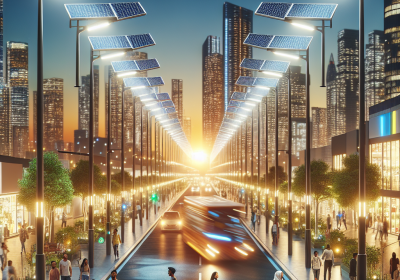Troubleshooting Common Problems with Commercial Solar Street Lights
Table of Contents
Commercial solar street lights are increasingly being adopted as a sustainable and cost-effective solution for outdoor lighting. However, like any technology, they can encounter issues that may affect their performance and reliability. Troubleshooting these common problems is essential to ensure that the lights operate efficiently and provide the intended benefits. This guide explores typical issues faced by commercial solar street lights, such as insufficient charging, flickering lights, and sensor malfunctions, and offers practical solutions to address these challenges. By understanding and resolving these problems, users can maximize the lifespan and effectiveness of their solar lighting systems, contributing to energy savings and environmental sustainability.
Identifying and Resolving Power Supply Issues in Commercial Solar Street Lights
Commercial solar street lights have become an increasingly popular choice for municipalities and businesses seeking sustainable and cost-effective lighting solutions. However, like any technology, they can encounter issues that may affect their performance. One of the most common problems faced by users is related to the power supply. Identifying and resolving these power supply issues is crucial to ensure the optimal functioning of solar street lights.
To begin with, it is essential to understand the basic components of a solar street light system. These typically include solar panels, a battery, a charge controller, and LED lights. The solar panels capture sunlight and convert it into electrical energy, which is then stored in the battery. The charge controller regulates the flow of electricity to prevent overcharging or discharging of the battery, while the LED lights provide illumination. When a power supply issue arises, it is often due to a malfunction in one or more of these components.
One common power supply issue is insufficient charging of the battery. This can occur if the solar panels are not receiving enough sunlight, which may be due to shading from trees, buildings, or other obstructions. To resolve this, it is important to ensure that the solar panels are installed in a location where they receive maximum sunlight throughout the day. Additionally, regular cleaning of the panels is necessary to remove dust and debris that can reduce their efficiency.
Another potential problem is the degradation of the battery over time. Batteries have a limited lifespan and their capacity to hold charge diminishes with age. If the battery is not holding charge as expected, it may need to be replaced. It is advisable to use high-quality batteries designed for solar applications, as these are more durable and reliable. Furthermore, ensuring that the charge controller is functioning correctly is vital, as it protects the battery from overcharging and deep discharging, both of which can significantly shorten its lifespan.
In some cases, the issue may lie with the charge controller itself. A faulty charge controller can lead to improper charging of the battery, resulting in insufficient power supply to the LED lights. If the charge controller is suspected to be the problem, it should be tested and, if necessary, replaced with a compatible model that meets the specifications of the solar street light system.
Moreover, wiring issues can also contribute to power supply problems. Loose or corroded connections can disrupt the flow of electricity between the components, leading to intermittent or complete failure of the system. Regular inspection and maintenance of the wiring are essential to ensure that all connections are secure and free from corrosion. If any damaged wires are found, they should be repaired or replaced promptly.
In conclusion, troubleshooting power supply issues in commercial solar street lights involves a systematic approach to identifying and resolving problems with the solar panels, battery, charge controller, and wiring. By ensuring that each component is functioning correctly and maintaining the system regularly, users can maximize the performance and longevity of their solar street lights. This not only enhances the reliability of the lighting solution but also contributes to the broader goal of sustainable energy use.
Addressing Sensor and Control System Malfunctions in Solar Street Lighting

Addressing sensor and control system malfunctions in solar street lighting is crucial for maintaining the efficiency and reliability of these systems. As solar street lights become increasingly popular due to their environmental benefits and cost-effectiveness, understanding how to troubleshoot common issues is essential for ensuring their optimal performance. One of the most frequent problems encountered with solar street lights is sensor malfunction. Sensors play a vital role in the operation of solar street lights, as they detect ambient light levels and trigger the lights to turn on or off accordingly. When sensors fail, the lights may not operate as intended, either staying on during the day or failing to illuminate at night.
To address sensor malfunctions, it is important first to verify the cleanliness and positioning of the sensors. Dust, dirt, or obstructions can interfere with the sensor’s ability to accurately detect light levels. Regular cleaning and maintenance can prevent such issues. Additionally, ensuring that the sensors are correctly aligned and not blocked by nearby structures or vegetation is crucial. If the problem persists despite these measures, it may be necessary to replace the sensor. In some cases, recalibrating the sensor settings can also resolve the issue, allowing the system to function correctly.
Another common issue with solar street lighting systems is control system malfunctions. The control system is responsible for managing the operation of the lights, including timing, dimming, and energy management. When the control system fails, it can lead to erratic lighting behavior, such as lights turning on and off at inappropriate times or not responding to changes in ambient light levels. To troubleshoot control system malfunctions, it is essential to first check the power supply and connections. Loose or corroded connections can disrupt the flow of electricity, leading to control system failures. Ensuring that all connections are secure and free from corrosion can often resolve these issues.
Moreover, software glitches or outdated firmware can also cause control system malfunctions. Regularly updating the system’s software and firmware can prevent such problems and improve overall performance. If the control system continues to malfunction despite these efforts, it may be necessary to consult with the manufacturer or a professional technician to diagnose and repair the issue. In some cases, replacing the control unit may be the most effective solution.
In addition to addressing sensor and control system malfunctions, it is important to consider the impact of environmental factors on solar street lighting systems. Extreme weather conditions, such as heavy rain, snow, or high winds, can affect the performance of these systems. Ensuring that the lights are designed to withstand local weather conditions and conducting regular inspections can help mitigate these effects. Furthermore, monitoring the battery health and solar panel efficiency is crucial for maintaining the overall functionality of the system. Batteries that are not holding a charge or solar panels that are not generating sufficient power can lead to reduced performance and reliability.
In conclusion, troubleshooting sensor and control system malfunctions in solar street lighting requires a systematic approach that includes regular maintenance, timely updates, and consideration of environmental factors. By addressing these common issues, it is possible to enhance the performance and longevity of solar street lighting systems, ensuring that they continue to provide sustainable and efficient lighting solutions for communities.
Solutions for Battery Performance and Longevity Challenges in Solar Street Lights
In the realm of sustainable urban development, commercial solar street lights have emerged as a pivotal innovation, offering an eco-friendly alternative to traditional street lighting systems. However, like any technology, they are not without their challenges. One of the most significant issues faced by users is related to battery performance and longevity. Understanding and addressing these challenges is crucial for ensuring the optimal functionality and lifespan of solar street lights.
To begin with, the performance of solar street light batteries is heavily influenced by environmental factors. Temperature fluctuations, for instance, can significantly impact battery efficiency. In colder climates, batteries may struggle to maintain their charge, while excessive heat can accelerate the degradation process. To mitigate these effects, it is advisable to use batteries specifically designed for extreme temperatures. Lithium-ion batteries, for example, are known for their resilience and ability to perform well across a wide temperature range. Additionally, ensuring that the battery housing is adequately insulated can help protect it from harsh weather conditions.
Another common issue affecting battery performance is improper charging and discharging cycles. Overcharging or deep discharging can lead to reduced battery capacity and lifespan. To address this, it is essential to incorporate a reliable charge controller within the solar street light system. A charge controller regulates the flow of electricity to and from the battery, preventing overcharging and excessive discharging. By maintaining optimal charge levels, the controller helps extend the battery’s life and ensures consistent performance.
Moreover, regular maintenance plays a vital role in preserving battery longevity. Periodic inspections should be conducted to check for signs of corrosion, loose connections, or physical damage. Cleaning the battery terminals and ensuring secure connections can prevent energy loss and improve efficiency. Furthermore, it is important to monitor the battery’s state of charge and health regularly. Advanced battery management systems can provide real-time data on battery performance, allowing for timely interventions if any anomalies are detected.
In addition to these technical solutions, strategic placement of solar street lights can also enhance battery performance. Positioning the lights in areas with maximum sun exposure ensures that the solar panels can capture sufficient energy to charge the batteries fully. Avoiding shaded locations or obstructions that may block sunlight is crucial for maintaining optimal energy input. In urban settings, where tall buildings or trees may cast shadows, careful planning and site assessment are necessary to identify the best installation spots.
Furthermore, the choice of solar panels can influence battery performance. High-efficiency panels can generate more electricity even in low-light conditions, ensuring that the batteries receive adequate charge throughout the day. Investing in quality solar panels with proven performance metrics can thus contribute to the overall reliability of the solar street lighting system.
In conclusion, while battery performance and longevity challenges are common in commercial solar street lights, they can be effectively addressed through a combination of technological solutions and strategic planning. By selecting appropriate battery types, implementing robust charge controllers, conducting regular maintenance, and optimizing installation locations, users can significantly enhance the performance and lifespan of their solar street lighting systems. As cities continue to embrace sustainable solutions, overcoming these challenges will be key to maximizing the benefits of solar street lights and contributing to a greener future.
Read more about Solar Street Lighting:
- Emerging Trends in Commercial Solar Street Lighting
- Commercial Solar Street Lights: Key Market Developments
- Durability and Lifespan of Commercial Solar Street Lights
- Aesthetic Advantages of Commercial Solar Street Lighting
- Sustainable Disposal and Recycling of Solar Street Light Components
- Analysing the Life Cycle Costs of Commercial Solar Street Lights
- Tax Incentives for Installing Commercial Solar Street Lights
- How Commercial Solar Street Lighting Can Boost Property Values
- Improving Public Spaces with Commercial Solar Street Lighting
- Maximizing Energy Collection with Commercial Solar Street Lights









